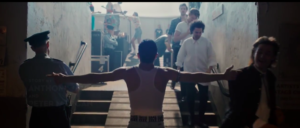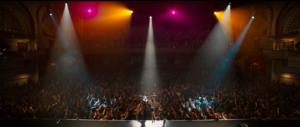Originally, I selected Bohemian Rhapsody because I had seen the film before and was amazed by the soundtrack and cinematography on screen. I have a fondness for classic rock music, and I was eager to learn more about the band Queen. During this project I learned a lot about the history of Queen and Freddie Mercury, while simultaneously learning how to analyze film and cinematography. I have seen Bohemian Rhapsody in its entirety about 5 times now, and I continue to learn, or pick up on something new each time I watch it. One of the most interesting takeaways I have learned from this project is that films can be analyzed and interpreted in many different ways. I now find myself much more aware of decisions made by the cinematographer and director in films, and how they evoke messages and ideologies to their audience in a similar way that authors do so in literature. Prior to this class and this final film analysis, I had never thought about movies as anything more than entertainment but the reality of it is that films reveal a lot about life lessons and culture. Bohemian Rhapsody in particular made me realize what struggles any famous person may face and that being a star is not as glamorous as the media presents it to be.
Month: December 2020
Ideological Analysis
The Bryan Singer film Bohemian Rhapsody contains ideologic meanings that are both implicit and explicit. Freddie Mercury, the main character in the film represents both the loneliness of stardom and the struggles faced by homosexuals in society.
Singer gives subtle hints at some of the internal struggles faced by homosexuals during the 1970s and 80s in the film through Freddie, who can not seem to accept himself for fear of losing the people that are close to him like Mary. Although there were no obvious signs of homophobic behavior by any of the characters in the film, Singer evokes an ideology about the past societal acceptance of gays through Freddie’s unwillingness to admit his sexuality for a majority of the fim. It was a hard time for members of the LGBTQ+ community, and Singer presents this theme implicitly.
Singer’s ideology about the loneliness of stardom however, was more explicit and obvious. After achieving great success as a singer, the film focused a lot on Freddie’s great wealth but lack of companionship. While on tour, the band was surrounded by people, groupies, and fans yet Singer juxtaposed this with continued clips of Freddie alone in his mansion. Celebrities can be surrounded by people yet still feel alone. This explicit ideology goes hand in hand with the implicit ideology about sexuality in the 1970s and 80s, creating a very difficult and isolated time for Freddie Mercury in the story.
On the ideological continuum, Bohemian Rhapsody could be placed between the centrist and liberal categories. Liberal ideals put an emphasis on equality and individual rights, and the liberal party was a big part of the LGBTQ+ movement of the 2000s. The implicit ideology about homosexuals made this film shift towards the left for me on the ideological continuum. However, I felt that the film was not very political and mainly focused on Freddie’s loneliness, so Bohemian Rhapsody should remain between centrist and liberal on the chart.
Newton Thomas Sigel is the cinematographer for the film Bohemian Rhapsody. He is most known for his work with director Bryan Singer on the films X-Men, The Usual Suspects, Valkyrie, and again, Bohemian Rhapsody. He has been the primary cinematographer for a number of films, many of which earned him awards for outstanding cinematography. Sigel has worked on films of numerous genres, and focuses his work on the storytelling aspect of movies. Critics say Sigel has no actual style of cinematography because of his ability to adapt to many different genres of cinema. The film Bohemian Rhapsody is dominated by medium shots, although Singer does include various different camera angles and viewpoints. An equal emphasis on both the characters and their setting is created through these–predominantly medium–shots. Sigel and Singer create a world on screen that resembles the life of Freddie Mercury during his time in Queen. Due to their accuracy at creating this view on screen, the movie is clearly realistic.

- Dominant: Our eye is first attracted to Freddie in the center of the frame, due to the fact that he is taking up a lot of space in the view with his arms spread open wide.
- Lighting/shading: The lighting in the image is unique because the main focus, Freddie is in the dark as he is coming out of the shadows onto the brightly lit stage at Live Aid. The contrast in lighting is powerful in this image as it captures the energy that radiates from a giant crowd for these performers.
- Proxemics: In this image Freddie Mercury is the main focus, as he gets excited to run on stage for unfortunately one of the last times. The audience can see his upper body from the waist up. Sigel likely chose this angle because he is lower than the stage, so it allows the audience to get a view of what goes on backstage before a concert while simultaneously viewing Freddie.
- Angle: The image is viewed from eye-level, as if you were standing behind Freddie following him up to the stage. Following this shot, the cameraman follows Freddie making it feel like viewers are right there running behind him.
- Color values: The colors in this shot are fairly dull. By keeping the colors dull Sigel is able to really emphasize the difference between light and dark. In the film, colors really emphasize what is happening in Freddie’s life. For example when the band is on tour of America and everything is going good for Freddie, the images on screen are vibrant and colorful, however when Freddie gets diagnosed with AIDS and his life falls apart, the dull colors reflect this struggle. At this final Live Aid concert–despite the tremendous accomplishment of performing at Live Aid–the fact that this could be Queens final performance together hangs heavy over Freddie and the band. Singer and Sigel portray this deeper emotion through the colors on screen.

*Here, the bright colors used during the bands great success on their tour of America is shown.
- Subsidiary images: After taking in the dominant image of Freddie, the audience can get a glimpse of how many other people there are working behind the scenes of a concert. Examining this image can also emphasize the theme that even when surrounded by thousands of people and fans, a star can still feel alone just as Freddie did in this film.
- Density: This image is moderately packed with visual information. Freddie is in the center of the frame which establishes some simplicity to the view, although as the viewer’s eye moves around the image, they can absorb a lot of visual information which foreshadows the importance of Freddie’s character in the film to come.
- Composition: The two-dimensional space is organized by the contrast in lighting created. The center and top of the image are brightly lit, bringing the audience’s attention to here. Freddie is a darker image in the center of this, depicting him as the most important figure in this scene. The tunnel in front of him also serves to force viewers to look at Freddie.
- Depth: This image contains all three planes of view. The background is higher up than the foreground, allowing for a clear view of the midground in the image. It is an interesting view because one can really feel Freddie transition from the foreground to the background through this tunnel, leaving backstage behind him.
- Character placement: Characters occupy all three planes in this frame, and seem to be scattered across all parts of the framed space. Freddie however is clearly the main focus of the image as he is directly in the center of the view and all these people.